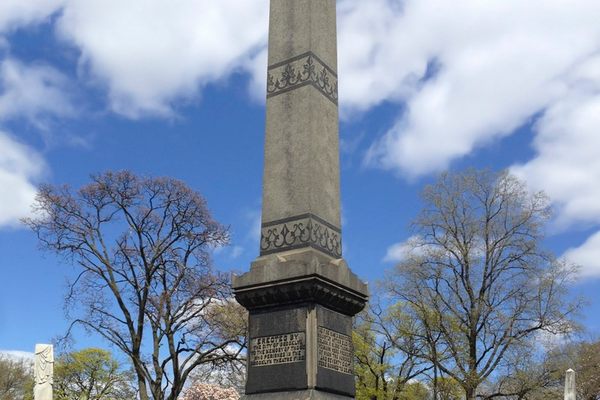Society Adventures: Cryptic Symbolism After Dark in Green-Wood Cemetery
Inside the Whitney mausoleum in Green-Wood Cemetery (all photographs by Steven Acres. View more of his work here: stevenacr.es)
Cemeteries have their own language. Through the shape of the stones and the symbols on them, you can get these coded glimpses into the lives of the people buried below. On the evening of the November full moon — appropriately called the Mourning Moon in some pagan traditions — the Obscura Society gathered in Green-Wood Cemetery in Brooklyn to explore some of this symbolism.
The Obscura Society viewing a monument
It was an incredibly foggy night which made the already beautiful cemetery incredibly atmospheric. I have been leading cemetery tours for Atlas Obscura in Green-Wood since 2011, but even with my familiarity with the Victorian rural cemetery, it still becomes something quite different after dark. We started with some of the basics of cemetery symbolism, like the obelisk (represented on our tour by a monument to the victims of the 1876 Brooklyn Theater Fire) that has been a symbol referencing a ray of the sun going back to ancient Egypt. We also viewed examples of fairly obvious symbols like angels taking people off to heaven — or in one instance, a child become an angel herself — and the heavily Christian symbols like crosses, the Chi Rho, and depictions of the saints.
The tomb of Charlotte Canda
However, there were also those more arcane symbols whose meaning would have been evident to 19th century visitors to Green-Wood, which was really New York City’s first popular public park and attracted day trip carriage rides and picnics with plenty of monument viewing, but for us is now obscure. That includes the rose, which when shown with its stem snapped represents a life cut short in its “bloom,” and was evoked on the grave of 17-year-old Charlotte Canda with a wreath of marble roses around her head that numbered her exact final age. There were also grapes for the blood of Christ, broken columns representing the end of life as well as a reference to the fact that even the grandest monuments have their end, and plenty of evergreen trees looming over our path as reminders of life even after death.
Some of the symbols inside the Whitney Mausoleum
Our lantern-lit walk through just a part of the cemetery’s 478 acres brought us to the Whitney Mausoleum. The octagonal chapel tomb was built by Stephen Whitney. The New York City merchant passed away in 1860, and although his fortune was second only to the Astors, you likely don’t know his name as he was notoriously stingy, not giving in any philanthropic way that would have left his name preserved on a building somewhere. It’s said that the last thing he did before dying was lock up his checkbook.
The Obscura Society guests in the Whitney Mausoleum
But we were there for the symbols. With warming hot toddies, we examined the strange symbols carved on the tombstones embedded in the marble walls. Most were iterations of the Christian trinity, as well as the pentagram, with trefoils represented by clover shapes echoing the trinity in a different form. It’s unclear where Whitney got the symbols, perhaps in a grimoire he got a hold of or maybe they reference his own take on the Key of Solomon. Either way, they are another example of this stone language that you can find in any cemetery, ready to be read.
Here are some more photographs of the exploration by Steven Acres:
The entrance to Green-Wood Cemetery, built in 1861 and meant to represent the front of a cathedral
The cemetery road at night
Carrying lanterns through the night
A mausoleum that was damaged by Hurricane Sandy
Jesus and Mary on an Egyptian pyramid, a common mixing of the pagan and Christian in Victorian cemeteries
Gathering at the pyramid
The Spencer family plot
The mausoleum of John Anderson, infamous for his involvement in the death of the “beautiful cigar girl” that inspired Edgar Allan Poe
The Pilot’s Monument for Thomas Freeborn, a harbor pilot who gave his life trying to save others on a stranded ship. The tomb is in the form of a broken ship’s mast with Hope personified holding an anchor at the top
The Whitney Mausoleum
The full moon over Green-Wood Cemetery
Thanks so much to Green-Wood Cemetery for collaborating with us on such a special event, to Steven Acres for the gorgeous photography, and to all who braved the foggy night for the adventure!
The Obscura Society is the real-world exploration arm of Atlas Obscura We seek out secret histories, unusual access, and opportunities for our community to explore strange and overlooked places hidden all around us. Join us on our next adventure!
All Upcoming Obscura Society Events
Facebook: Obscura Society San Francisco













Follow us on Twitter to get the latest on the world's hidden wonders.
Like us on Facebook to get the latest on the world's hidden wonders.
Follow us on Twitter Like us on Facebook